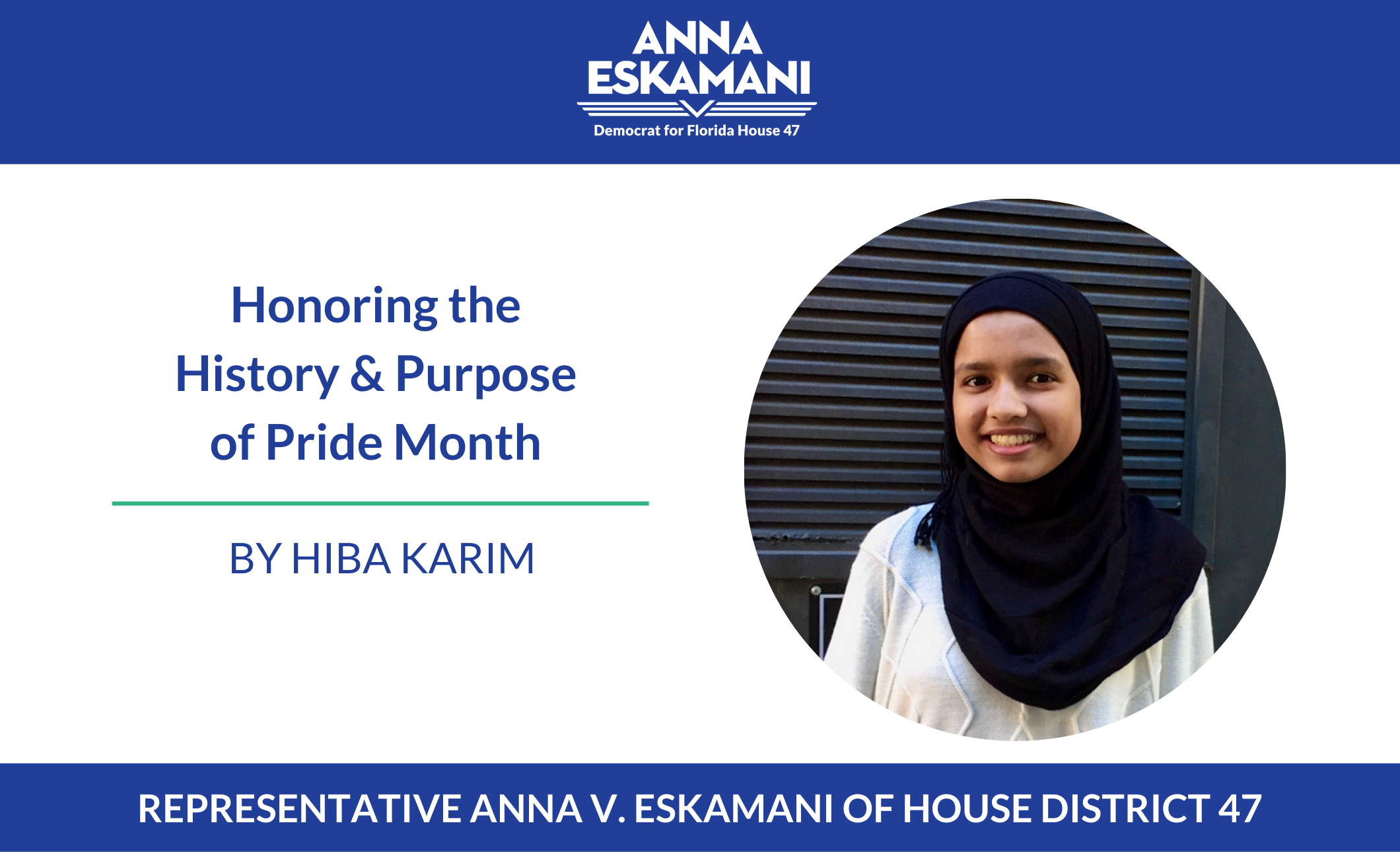
About the author: Hiba Karim is a rising freshman at the University of Florida and current intern with Representative Anna Eskamani’s Legislative Office.
This June marked Pride Month, where we celebrate LGBTQIA+ communities around the globe! Months like June are celebrated to honor and uplift the spirits of LGBTQIA+ communities. We know even in recent history there has been aggression and multiple exclusions of communities. We can see this in 2017 when political administrations passed Health Care and Social bills, which declined fewer benefits to women and the LGBTQIA+ community, and targeted transgender bathroom rights. The hate continued as the Florida Legislature passed a bill this past session that attacked transgender student athletes, restricting them from playing. As these attacks intensify, we must remember that that fight is not over and that we should remember and honor all those impacted during this month of Pride.
Pride, by definition, is a way to express emotions, identity and during this month, it is about self-respect and opening up on one’s sexuality. Pride Month also highlights the influences made upon society and politics by the LGBTQIA+ communities and understands the challenges they face to this date. As Pride Month comes to an end, we’re taking the time to reflect and remind others that we can create a safer and inclusive community by being together and fighting for the good fight.
The History of Pride
Being open about your sexuality in the late 1900s was seen as a criminal offense. Hence, individuals identified as LGBTQIA+ would gather in groups to late-night parties and bars to be included with individuals similar to them. For the LGBTQIA+ communities, being in groups and standing up for one another meant that they were undefeatable due to the power they held as a whole. One of these gatherings was at a bar, Stonewall Inn, a famous gay bar in New York City. On June 28, 1969, police raided the bar. Through a series of arguments and thrown objects, this event became one to remember for years. Days following this raid, communities were furious at the hatred spewed upon the LGBTQIA+ communities. As a result, there were multiple rebellions and protests. Jim Fouratt, a participant of these protests, stated in a New York Times interview, that the energy fueling the events “was a rebellion from within.” In other words, it was a fight needed to happen to ensure that LGBTQIA+ rights were accepted into society and in politics. The following six days after the Stonewall raid became the Stonewall Uprisings – an event in history that fueled the Gay Liberation Movement.
One year later, on June 28, 1970, over five thousand individuals hosted a Pride march, commemorating the Stonewall Uprisings’ first anniversary. This protest was known as the Christopher Street Liberation Day and was seen as a way to fight against the centuries of abuse held in homophobia.
How is it celebrated?
Pride Month is welcomed with bright colors and calendars filled with events. Cities around the world start June 1st by displaying their full support. Businesses begin to hang Pride flags around offices. Community organizations host Pride parades, protests, and activities. Many organizations also provide outreach and volunteer resources for individuals that would like to help out during June. You can also look at lists of Pride events and organizations around the world!
How can we celebrate it now?
As COVID restrictions are slowly being lifted in many countries, in-person events are becoming the norm again. However, this is not the case in every country. So, how can we utilize our support digitally for the LGBTQIA+ communities around the world? In the new age of digital media, many resources and events allow millions to connect. Some examples include:
- Virtual Open-mics; showcasing the talents of LGBTQIA+ communities
- Virtual meet and greets
- Virtual seminars
- Spread information to educate others
- Host Zoom calls to converse
- Reach out to individuals and show your support
- Support LGBTQIA+ small businesses
- Donate to LGBTQIA+ nonprofits
- Virtually Volunteer
- Showcase digital art in honor of Pride
What else can we do?
In addition to showing our support and uplifting those who have been silenced for years, we must also take a step back and educate ourselves on what Pride genuinely means. We must understand that individuals in the LGBTQIA+ communities face many challenges in the workplace, school, and the public eye. Although we may not understand how it feels to deal with such challenges, we can learn more about the history, listen to stories, and become better allies & accomplices. We can expand our vocabulary by exploring the terms commonly used in LGBTQIA+ communities and hearing stories from others. Below are two different sources where you can gain an additional perspective:
